by John M. Hotchner
Click on stamp illustrations for larger versions
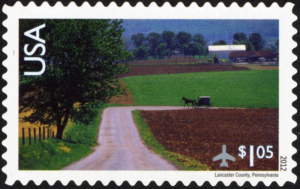 Quick – What is the first U.S. postage stamp to have a face value of a dollar or more? What was the first U.S. postage stamp to have a face value of over $10? Are there any U.S. Air Mail stamps with a value of more than a dollar, prior to the 2012 $1.05 Scenic American Landscape issue (“Amish Horse & Buggy on Road, Lancaster, Country, Pennsylvania”)? The answers will be found later on in this column.
Quick – What is the first U.S. postage stamp to have a face value of a dollar or more? What was the first U.S. postage stamp to have a face value of over $10? Are there any U.S. Air Mail stamps with a value of more than a dollar, prior to the 2012 $1.05 Scenic American Landscape issue (“Amish Horse & Buggy on Road, Lancaster, Country, Pennsylvania”)? The answers will be found later on in this column.
 There are a surprising number of U.S. dollar-value issues. If we include booklet panes and se-tenant blocks and strips that total to more than a dollar, the list is quite long. So, let’s ignore those for the present. The dollar-value single stamps are a significant challenge by themselves.
There are a surprising number of U.S. dollar-value issues. If we include booklet panes and se-tenant blocks and strips that total to more than a dollar, the list is quite long. So, let’s ignore those for the present. The dollar-value single stamps are a significant challenge by themselves.
Believe it or not, there were 28 different dollar value stamps issued through the end of the Third Bureau Issue (the so-called “Washington-Franklins”). They are not all face-different. There are 16 different major designs, including the same design with different values. The rest are minor design variations, or varieties of watermark, perforation gauge or color.
In mint condition, a complete collection is well beyond the resources of most collectors. It is certainly beyond mine! But owning even a few is a thrill! And many of them are quite reasonable in used condition. Beginning with the 1922 Fourth Bureau Issue, even the mint examples are reasonable, and almost all used copies are not much more expensive than a movie rental, and usually less than their face value.
Let’s skip around a bit and look at some of the dollar stamps of the United States: First, the answer to the first question above. Surprisingly, the first dollar values were issued on January 1, 1893, 46 years after the first U.S. stamps. They were the $1, $2, $3, $4, and $5 commemorative stamps issued to publici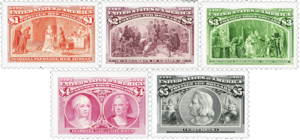 ze the World’s Columbian Exposition in Chicago, Illinois, to be held from May 1 to October 30, 1893; a total of $15.
ze the World’s Columbian Exposition in Chicago, Illinois, to be held from May 1 to October 30, 1893; a total of $15.
Beautiful as these stamps were, and they remain popular today, there was considerable public outcry about the length of the set. Remember, back then, a dollar was a prized amount of money. For example, in 1893, a laborer earned about $9.50 for a 60-hour work week! And even though a dollar went a lot further — $1 from 1893 would be equivalent to $29.67 in 2021 dollars — I am certain that the average collector would have had plenty of other uses for $15 in 1893! But it would have been a decent investment for someone on behalf of their great- great- grandchildren, as the Scott Catalogue value for a mint set of the dollar values is now $8,150; $29,300 if never hinged!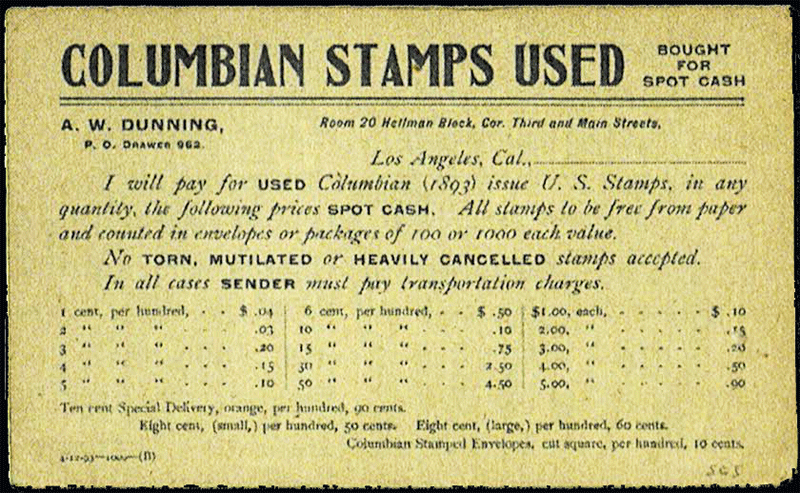
A 1901 penny postal card from a dealer in California [above] advertised to buy used Columbians. Note that he is offering 90 cents for each $5 stamp that he accepts. Today, a used $5 Columbian catalogues $1,200!
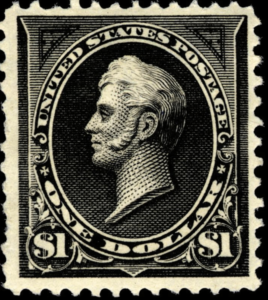 Moving along, one of my favorite designs from the early years of dollar stamps is the 1894 gem picturing Oliver Hazard Perry; a figure I’d bet precious few college seniors could place in historical context today – if they ever heard of him at all!
Moving along, one of my favorite designs from the early years of dollar stamps is the 1894 gem picturing Oliver Hazard Perry; a figure I’d bet precious few college seniors could place in historical context today – if they ever heard of him at all!
There are four versions: Unwatermarked Types I and II, and double-line watermarked Types I and II. [The watermarked versions of this stamp, both Types, were also overprinted for use in Guam and the Philippines.]
The difference between the Types is found in the circles at the lower right and left corners surrounding the $1 denomination. On Type I stamps, the circle is broken where it meets the curved line below “One Dollar.” On Type II stamps the circle is complete. 75% of the stamps produced were Type I; the remainder Type II. It follows that the catalogue values are twice as high for Type II as Type I.
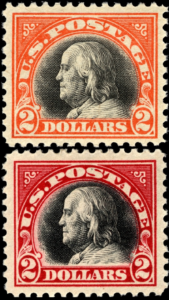 Colors play an important part in the story of the $2 1918 Franklin. The first issued was the $2 “orange red and black” (as listed in Scott, #523), on August 19, 1918. Max G. Johl, in his monumental The United States Postage Stamps of the 20th Century, tells us that the official descriptions prior to release of the stamp, and afterward as well, said that the colors were red and black. Clearly what came off the presses is not red, so the Scott listing of orange-red and black is correct.
Colors play an important part in the story of the $2 1918 Franklin. The first issued was the $2 “orange red and black” (as listed in Scott, #523), on August 19, 1918. Max G. Johl, in his monumental The United States Postage Stamps of the 20th Century, tells us that the official descriptions prior to release of the stamp, and afterward as well, said that the colors were red and black. Clearly what came off the presses is not red, so the Scott listing of orange-red and black is correct.
But on November 1, 1920, a new printing was released, and these are without question red [which Scott calls “carmine”] and black. They have been given a separate Scott listing, #547. A total issued for both is 791,000, and fewer than 10% of those are #523.
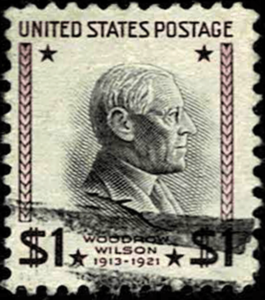 Jumping ahead to the 1938 Presidential issue, there are several color variations of the $1, caused by the fact that production methods and ink composition elements changed during the production period which extended from 1938 to 1956. Over 340.4 million were released. In addition, all the Prexie dollar values (as well as the $5 Fourth Bureau Issue; issued in 1923) were bicolors printed in two passes.
Jumping ahead to the 1938 Presidential issue, there are several color variations of the $1, caused by the fact that production methods and ink composition elements changed during the production period which extended from 1938 to 1956. Over 340.4 million were released. In addition, all the Prexie dollar values (as well as the $5 Fourth Bureau Issue; issued in 1923) were bicolors printed in two passes.
There are no known inverts, but there are plentiful color misregistrations. On the example shown on the left, Wilson’s portrait and other black printing is shifted to the right.
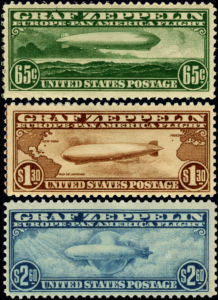 The first Air Mail dollar values are the so-called “Zeppelins” of 1930. Of the three stamps in the set, two (Sc. C14 and C15) are dollar values: a $1.30 and a $2.60. The former was intended to pay the postage on letters dispatched by steamer to Friedrichshafen and then via the Graf Zeppelin to Seville, Pernambuco and Rio de Janeiro. The $1.30 also covered the entire trip, with the addition of Rio to Lakehurst, New Jersey. The $2.60 paid the rate for the entire trip on letters all the way to Lakehurst.
The first Air Mail dollar values are the so-called “Zeppelins” of 1930. Of the three stamps in the set, two (Sc. C14 and C15) are dollar values: a $1.30 and a $2.60. The former was intended to pay the postage on letters dispatched by steamer to Friedrichshafen and then via the Graf Zeppelin to Seville, Pernambuco and Rio de Janeiro. The $1.30 also covered the entire trip, with the addition of Rio to Lakehurst, New Jersey. The $2.60 paid the rate for the entire trip on letters all the way to Lakehurst.
Short of the 24¢ Jenny invert, the Zeppelin set is the key for Air Mail issues, and gives a collector bragging rights when showing off his or her U.S. collection.
In the modern era, dollar value stamps became ubiquitous with the inauguration of Priority 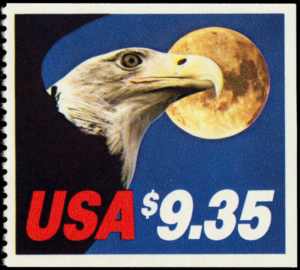 and Express Mail. The first high-value U.S. stamp above $5 was the first Express Mail stamp of 1983; a $9.35 jumbo. The first stamp over $10, was issued just two years later when the Express Mail rate was boosted to $10.75. In fact, the Express Mail and Priority Mail rates have changed so rapidly that over 40 face-different stamps have been issued for these services. For a collector of mint U.S. stamps, this represents an expenditure of about $375 as a contribution to the USPS bottom line. Of course, used examples of these large, beautiful stamps cost much less; the challenge being to find examples in good condition with light cancels.
and Express Mail. The first high-value U.S. stamp above $5 was the first Express Mail stamp of 1983; a $9.35 jumbo. The first stamp over $10, was issued just two years later when the Express Mail rate was boosted to $10.75. In fact, the Express Mail and Priority Mail rates have changed so rapidly that over 40 face-different stamps have been issued for these services. For a collector of mint U.S. stamps, this represents an expenditure of about $375 as a contribution to the USPS bottom line. Of course, used examples of these large, beautiful stamps cost much less; the challenge being to find examples in good condition with light cancels.
Covers with dollar values are interesting and collectible. In general, they are not scarce, with the exception of solo usages where a dollar-value stamp covers basic postage and additional services; the cost of which tote up to the face value of the stamp.
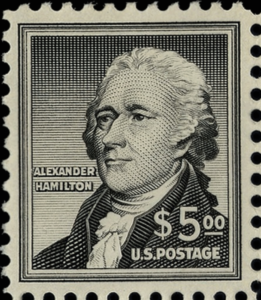 On-cover usage is often listed in the Scott U.S. Specialized Catalogue, and there can be some nice surprises. For example, the $5 Alexander Hamilton of the Liberty series of 1954 (Sc. 1053) has a used value in Scott of $6.75. It is a fairly scarce stamp in used, well-centered condition with a light cancel.
On-cover usage is often listed in the Scott U.S. Specialized Catalogue, and there can be some nice surprises. For example, the $5 Alexander Hamilton of the Liberty series of 1954 (Sc. 1053) has a used value in Scott of $6.75. It is a fairly scarce stamp in used, well-centered condition with a light cancel.
But find this stamp on the following covers, and you may have a real bonanza:
- On registered bank tag: $25.00
- On air parcel-post tag: $75.00
- On commercial cover: $1,800
- Single franking on registered cover: $7,000
An unusual usage of the Americana Series $5 (Scott #1612) pays the major part of charges for Air Mail, Special Delivery and Registry (with a return receipt) service from Miami, Florida to Guatemala City, Guatemala. Scott does not yet list a special premium for usages of this stamp, but I am certain that will come, as they are anything but common.
We have hardly scratched the surface of dollar-stamp collecting, but I hope you catch a little of my enthusiasm. It is a worthy challenge as a specialty, and yet, one that at least in the modern era, need not cost an arm and two legs!




Nice article, john
Clear and to the point!
Thanks